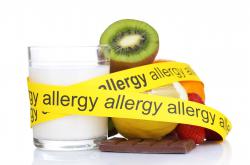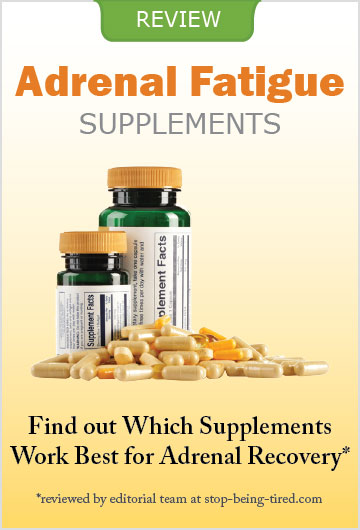Food Allergies and Sensitivities – And Their Impact on Adrenal Fatigue
Allergic reactions and food sensitivities can wreak havoc on adrenal glands and lead to dramatic worsening of adrenal fatigue. That is why it is critical to learn the most common allergens that may be affecting your health, as well as the best methods and tests for identifying these allergies.
The dangers associated with food allergies are fairly well understood by most people. Restaurants and other places where food is served routinely make note of the presence of the most common allergens, so that those with an increased sensitivity to those foods can better avoid them. When it comes to how these food allergies and sensitivities can affect people suffering from hypoadrenia, however, there is often a lack of proper awareness even among the patients.
And make no mistake; any sensitivity to the foods in your diet can have a tremendous impact on your health if you’re dealing with any level of adrenal fatigue. And it’s not just that allergic reactions can be so severe that they can sometimes be life-threatening. Even the milder sensitivities can play havoc with your body’s physiology, and contribute to the cycle of stress that overtaxes your adrenals and leaves you in a weakened and exhausted state.
Histamine, Cortisol, and the Adrenal Glands
While food allergies are a danger for anyone who must endure them, they pose a special risk for hypoadrenia patients. The problem all boils down to the impact that these allergic reactions have on the demand for cortisol. That hormone is produced by the adrenals, and excess demand for it has the effect of overtaxing those glands.
When you’re allergic to something, your body’s most common reaction involves releasing histamine, as well as other compounds that stimulate inflammation. This inflammation is the body’s natural response to any attack on the immune system. While this might seem like a good thing, the reality is that the body is not designed to endure high levels of histamine. To counter that danger, the adrenals leap into action and begin to produce greater levels of cortisol to reduce the inflammation.
Of course, nothing is ever quite that simple for adrenal fatigue sufferers. For a normal, healthy person with strong adrenal glands, the increase in cortisol would be a net positive. If you have adrenal fatigue, however, that reaction is just one more stress factor that can lay waste to your adrenals. As the histamine levels rise, your body has to produce even more cortisol to offset its effects. That extra work increases the demands on your already-exhausted adrenals, and they struggle to keep pace.
Their inability to properly offset those histamine levels leads to greater inflammation, and even more demand for cortisol. Ultimately, you either end up with an allergic reaction that is beyond your body’s ability to manage, or adrenals that are so exhausted that your fatigue syndrome grows even worse.
Obviously, it is vital that hypoadrenia patients with food allergies recognize the dangers, and do everything they can to eliminate those allergens from their diets. That can help to ensure that the demands placed upon the adrenals are minimized as much as possible.
Common Food Allergies
While anyone can be allergic to almost any type of food or drink, there are some common allergens that deserve mention:
- Fish allergies can be difficult to pin down, since many who are allergic to fish such as halibut or tuna have no sensitivity to lobster or other shellfish. In fact, people can be allergic to one variety of fish and do just fine eating another.
- Milk is among the most common food allergens. The only good news for anyone suffering from this allergy is that there are so many different kinds of milk alternatives on the market that it is fairly simple to avoid those that cause an allergic reaction by simply drinking one of the alternatives.
- Wheat allergies can range from mild sensitivity to various grains to the more severe celiac disease. If you suspect that you are allergic to these grains, consult with an allergist to determine the exact nature of the sensitivity. This is critical, since wheat is such a common ingredient in most people’s diets.
- Chocolate is one of the trickiest of foods for hypoadrenia sufferers to forsake. After all, who really wants to contemplate giving up this delicious food? Unfortunately, even adrenal fatigue patients without an allergy to chocolate can suffer from increased fatigue when they eat this substance. The bottom line: eliminate it from your diet.
- Soy allergies are becoming more common in many areas as well. While they are rarely life-threatening, they still pose a serious risk to adrenal fatigue patients.
- Eggs can pose a danger to anyone whose immune system mistakenly recognizes the protein in the yoke or egg white as an invading entity rather than as nourishment. As a general rule, people with this allergy can have increased sensitivity to any type of eggs.
- Peanuts can be especially worrisome, since many patients do not even have to ingest them to suffer an allergic reaction. Even cursory contact with the airborne proteins can present life-threatening dangers.
- Beef allergies are less common in most places, but can be troublesome due to their tendency to encompass other types of red meat as well.
- Tomatoes can cause quite severe reactions if you’re allergic to them and can even lead to difficulty breathing, or anaphylactic shock.
- Corn, while not as common yet as some of the others listed, is becoming more commonplace with each passing year – aided in no small part by the fact that it is now used in more and more food products.
Signs of Sensitivity
There is no hard set of rules for determining whether your reaction to any food actually indicates an allergy – short of going into anaphylactic shock, that is. Still, there are some things you can watch for to determine whether some of the foods you’re eating are actually creating more stress for your adrenals.
One thing to watch for is whether you start to feel the more severe symptoms of your fatigue after eating a certain kind of food. Keep in mind, of course, that a given food’s impact on you can vary from day to day as well. Often times, the impact may just be a general sense of confusion or the sensation that your head is in a mental fog of sorts. In more severe instances, you may even fall unconscious. The key is to monitor how your body reacts to different foods, and to note any that seem to produce odd effects.
As you begin to identify the possible allergens, you’ll need to test to see if you are indeed allergic.
Lab Tests
For most people with allergies, the process of definitively identifying the offending allergies takes place in the laboratory. One of the most effective tests for identifying these allergens is known as the Elisa food panels test. With just a single blood sample, you can be tested for more than a hundred different food allergies, spices, condiments, and other things you’re likely to eat or drink.
The Cellular Immune Food Reaction Tests are often used instead of or in addition to Elisa, to pick up possible allergies that might otherwise be missed. These tests - which are sometimes better known as the DTH (delayed-type hypersensitivity reaction tests) or ACT (activated cell tests) - are adept at detecting sensitivities that sometimes take days to appear after a food is consumed.
With a combination of those two tests, most patients can gain a comprehensive and accurate understanding of which food compounds are causing their problems. With that knowledge, it is then possible to create a list of every food you currently eat that contains any of those compounds, and begin the necessary process of eliminating each and every one of them from your diet.
Of course, there are instances in which the laboratory exams may not provide all the answers you need. When that happens, you can still discover which food substances are making you sicker by doing a little investigative work of your own. It’s a more arduous process, but one that must be engaged in if you’re serious about your adrenal recovery plan. The good news is that these methods only require good note-taking and clear observation skills.
Home Tests
Even after you’ve eliminated contact with your known allergens, there may still be food sensitivities that you need to address. There are four main ways to identify these problems:
Method 1: Observe
This method is helpful when you’re unsure about which foods are causing your difficulties. You have to first track your reaction to certain foods, and then remove them – one at a time, of course, from your diet to test the results. Try to limit the removal time to a couple of weeks, and then record your body’s reaction to the food once you add it back into your diet plan. Keep track of all the results, and repeat this process for every food item you fear might be a problem.
Method 2: Food Diary
In this system, you simply observe your reaction to different foods you consume, and record all your observations in a journal. To do this properly, you need to record everything you eat and drink, as well as where you ate it. That can help you to identify some foods that might not even be coming from your own kitchen, but rather from some obscure ingredient used in a restaurant or other setting.
Method 3: Reflection
This method requires you to track all foods and drinks, as well as symptoms you feel throughout each day. You do this for seven days, and then review the data to see if there is any pattern between the substances you consume and your symptoms. Even when this method produces no clear results for you in determining allergies or sensitivities, it still provides a useful tool for any consultation with an allergist or your family doctor. Note also that it is especially important to carefully monitor your symptoms in the morning, since that can be an extremely hazardous time for any adrenal fatigue sufferer.
Method 4: Cocoa Pulse
Based on the works of Arthur Cocoa, this test involves monitoring your pulse after you eat. You simply check your pulse prior to the meal, and then check it again fifteen minutes and a half hour after you’re done eating. If you’re having any sort of adrenal response as a result of anything you’ve eaten, your heart rate will increase. Again, track these results – both the food you eat and the pulse readings. Over time, you may be able to isolate and identify the foods that cause you problems.
Even so, it is important to bear in mind that the Cocoa Pulse test is rarely effective for those suffering from mild hypoadrenia. In those patients, the change in heart rate is often so insignificant that it is barely noticeable.
Confirming Your Results
The final step for all these home tests involves confirmation. If you believe that you’ve identified potential food allergens, you have to start eliminating them from your diet for several weeks or a month to see if the absence produces positive results. That means removing every food product that contains the potential allergen. If milk is the suspected culprit, then be prepared to get rid of every dairy-based product in your refrigerator.
After the elimination period has passed, you should try adding the food item back into your diet – in small amounts - to test your reaction. Always eat that food item by itself so that you can be sure that the reaction you’re observing is only a reaction to that particular substance. Be prepared for the common euphoric sensation that often accompanies the reintroduction of foods in this manner, as well as the subsequent energy crash. You’ll have to try the food on several consecutive days, since it can sometimes require more than one reintroduction to provoke a response.
If, after that process, you see regular reactions, you can be fairly certain that you have some level of sensitivity to the food item. If no reaction occurs, you are probably safe to leave the item in your dietary plan. Mild reactions often indicate food items that you can eat on a sporadic basis, but that you would no doubt be better off removing from your diet.
One test that you should skip altogether is the old skin test that some allergists continue to rely on in their practices. The fact is that those tests have been proven to provide false positives on a regular basis, which makes them unreliable for your needs. A combination of the laboratory tests and these home tests is really the best way for you to properly – and, more importantly, accurately – identify the foods that are playing havoc with your adrenal glands.
Get Rid of Them All
As you complete your list of foods that worsen your fatigue, you may see more than a few items that you find almost impossible to part with. You may even think to yourself that the price you pay for continuing to eat those particular foods is a small one when compared to the deprivation you’d feel if you eliminated them from your diet. Avoid that temptation like the plague!
Remember your goal. You want to regain your health, your vitality, and your quality of life. Doing that requires sacrifices at times, but those sacrifices will someday seem insignificant once you have achieved your recovery goal. Your only concern now should be to do whatever it takes to help your adrenals begin to heal and regain their normal function. To do that, every single allergen you identify must be eliminated from your life.
Your adrenal glands will thank you for it someday!
You might also be interested in:
- Adrenal Fatigue and Allergies. http://www.canaryclub.org/adrenal-fatigue-and-allergies.html
- What Does Adrenal Fatigue Have to Do With Allergies? http://www.healthsachoice.com/allergies/what-does-adrenal-fatigue-have-to-do-with-allergies/
- Nutritional Approaches for Allergies. http://drlwilson.com/articles/allergies.htm
- The Danger of Hidden Food Allergies. http://www.cbn.com/health/nutrition/drlen_031207.aspx
- Adrenal Fatigue - the 21st Century Stress Century Syndrome. James L. Wilson















.jpg)




Leave a comment